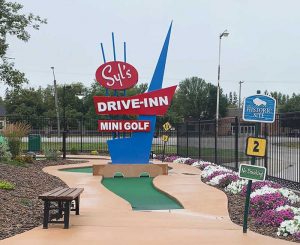A blast from the past
by brittney_cutler | 27 October 2021 5:00 pm
 [1]
[1]The main sign was also built from welded steel plates and powder-coated. There were 52 pieces in all, coated in three colours. The sign was assembled in three segments for shipping and bolted to the custom-made pallet. The client, who has construction experience, did the onsite assembly.
Entrepreneurs Travis and Stacie Enns from Carman, Man., wanted to add a mini-putt course to entertain guests and create another revenue stream for their thriving restaurant business, Syl’s Drive-In, founded in the 1960s.
Imagination Corporation from Chilliwack, B.C. bid with a 1960s car theme and period signs—all in a cartoon style. It got the job on its proposed design of a gas station, which would be the clubhouse, while period signs would provide the decor.
The Chilliwack firm designed more signs and features than the initial budget allowed. The client picked some for the initial build with the intent to add more signs and features in coming years, thus ensuring a fresh look each year as guests returned.
Much of the fabrication work was done by hand at the Chilliwack studio. For most of the pieces, a structural pencil-rod steel framework was welded together. The fabricators then trowelled on a thick coat of fibreglass-reinforced concrete and hand-carved the details into the wet mix. After the concrete was fully cured, the features were hand-painted. This size of project allowed the design firm to work on multiple pieces simultaneously in an almost production line set-up.
Then COVID-19 hit, and like many others, the project was delayed. After much discussion, the client decided to press on, and once the initial pieces were ready, they were packed up and shipped off to Manitoba.
Unexpectedly, the client asked the design firm for a site visit to help lay out the facility. It meant a long, 2200-km road trip, with staff sleeping in the back of the vehicle along the way. The client provided a travel trailer onsite and takeout meals. Over three long days. the layout was finalized, grades were set, and framing and pouring of the concrete was supervised. On the final day, a giant crane lifted all the features and signs into place.
The client had a great first season and last winter embarked on the second phase of the project. COVID worries kept the order down to a single large piece—the 1960s-style pylon sign, the foundation for which had been poured the previous year.
The sign was constructed of welded steel plates. The pieces were designed using EnRoute Pro software and were cut from 10-gauge steel on MultiCam plasma cutter and then welded together using Miller MIG welders. It was ground smooth, test-fitted, disassembled, and sent for powder coating. Once coloured, the three sections were reassembled before bolting it to custom-welded steel pallets for secure delivery. The client, who has construction experience, did the assembly onsite.
~Blair Adams
- [Image]: https://www.signmedia.ca/wp-content/uploads/2021/10/22-syls-installed.jpg
Source URL: https://www.signmedia.ca/a-blast-from-the-past/